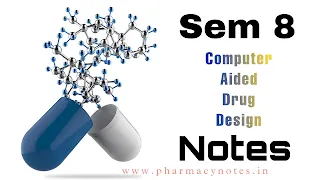BP 807 ET. COMPUTER AIDED DRUG DESIGN (Theory)
Scope: This subject is designed to provide detailed knowledge of rational drug design processes and various techniques used in the rational drug design process.
Objectives: Upon completion of the course, the student shall be able to understand
- Design and discovery of lead molecules
- The role of drug design in the drug discovery process
- The concept of QSAR and docking
- Various strategies to develop new drug-like molecules.
- The design of new drug molecules using molecular modeling software
Course Content:
UNIT-I
Introduction to Drug Discovery and Development
Stages of drug discovery and development
Lead discovery and Analog Based Drug Design
Rational approaches to lead discovery based on traditional medicine,
Random screening, Non-random screening, serendipitous drug discovery, lead discovery based on drug metabolism, lead discovery based on clinical observation.
Analog Based Drug Design: Bioisosterism, Classification, Bioisosteric replacement. Any three case studies
UNIT-II
Quantitative Structure-Activity Relationship (QSAR)
SAR versus QSAR, History, and development of QSAR, Types of physicochemical parameters, experimental and theoretical approaches for the determination of physicochemical parameters such as Partition coefficient, Hammet’s substituent constant, and Tafts steric constant. Hansch analysis, Free Wilson analysis, 3D-QSAR approaches like COMFA and COMSIA.
UNIT-III
Molecular Modeling and virtual screening techniques
Virtual Screening techniques: Drug likeness screening, Concept of pharmacophore mapping and pharmacophore-based Screening,
Molecular docking: Rigid docking, flexible docking, manual docking, Docking based screening. De novo drug design.
UNIT-IV
Informatics & Methods in drug design
Introduction to Bioinformatics, chemoinformatics. ADME databases, chemical, biochemical and pharmaceutical databases.
UNIT-V
Molecular Modeling: Introduction to molecular mechanics and quantum mechanics.Energy Minimization methods and Conformational Analysis, global conformational minima determination.
Recommended Books (Latest Editions)
1. Robert GCK, ed., “Drug Action at the Molecular Level” University Prak Press Baltimore.
2. Martin YC. “Quantitative Drug Design” Dekker, New York.
3. Delgado JN, Remers WA eds “Wilson & Gisvolds’s Text Book of Organic Medicinal & Pharmaceutical Chemistry” Lippincott, New York.
4. Foye WO “Principles of Medicinal chemistry‘ Lea & Febiger.
5. Koro lkovas A, Burckhalter JH. “Essentials of Medicinal Chemistry” Wiley Interscience.
6. Wolf ME, ed “The Basis of Medicinal Chemistry, Burger’s Medicinal Chemistry” John Wiley & Sons, New York.
7. Patrick Graham, L., An Introduction to Medicinal Chemistry, Oxford UniversityPress.
8. Smith HJ, Williams H, eds, “Introduction to the Principles of Drug Design” Wright Boston.
9. Silverman R.B. “The Organic Chemistry of Drug Design and Drug Action” Academic Press New York.









Please do not enter any spam link in the comment box.